Samraong, Cambodia: Teuk Buntoeun was picking through shrapnel and rubble when his still-ringing ears caught the spin from Bangkok. It went like this: Thailand had sent an F-16 fighter jet over the dividing Dangrek mountains, precision-pounding Cambodian military positions. The news was already all over the global media.
The Thai military reported that the mission was successful – and fair. Unlike Cambodia, which it has accused of breaching the Geneva Conventions, Thai strikes “do not target civilian areas or any locations unrelated to military operations”, the military claimed.
“But this is not true,” Buntoeun says, gesturing to the damage all around him. “This is a pagoda.”
Teuk Buntoeun stands among the ruins of what was a dormitory for monks and temple workers, at the Ta Moan Sen Chet Pagoda. Credit: Kate Geraghty
In his telling, more than 20 people were at the Ta Moan Sen Chey pagoda, a Buddhist place of worship, when the bombing started shortly before 5pm on July 24, the first day of what would become a five-day war between Thailand and Cambodia. One of those people, a lay worker, was crushed under the collapsed walls of a dormitory and killed.
“His name was Kheang. He was 73 years old,” says Buntoeun, the pagoda’s chief achar – a lay person responsible for a temple’s good order and certain rituals. Kheang had been homeless until Buntouen offered him shelter three years ago.
The pagoda, built in 2011, is a now mess of steel and shattered roof tiles. The concrete at the front is gouged and strewn with debris. Among it all is piece of bomb printed with the words, “for use on MK82”, made in 2023.
Buntoeun and his deputy, Prum Chenda, hurry us along through giant boulders to the obliterated dormitory where Kheang died and two others were injured. Abandoned orange robes belonging to the monks who fled lie tangled in twisted tin and timber.
The cost of war
Ta Moan Sen Chey Primary School, which held classes for its 30 young pupils right up to July 23 – the day before the fighting – is a short walk away.
The kindergarten room is the worst hit. School principal Lay Phalla crunches over tiles, past a shrapnel-pocked whiteboard and walls covered in torn, dangling posters, and scoops up a shorn laptop near a tiny pink chair. He flings the broken equipment onto the teacher’s desk.
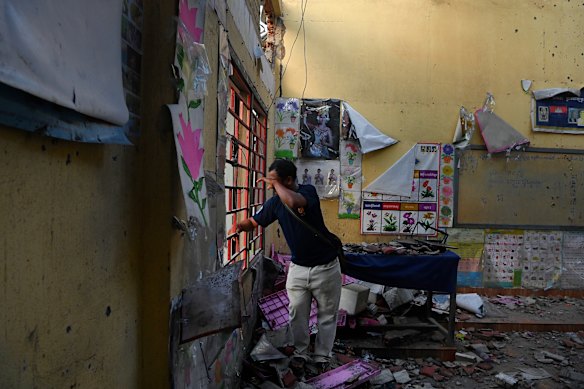
Ta Moan Sen Chey primary school principal Lay Phalla takes in the kindergarten classroom that was destroyed by Thai military bombing.Credit: Kate Geraghty
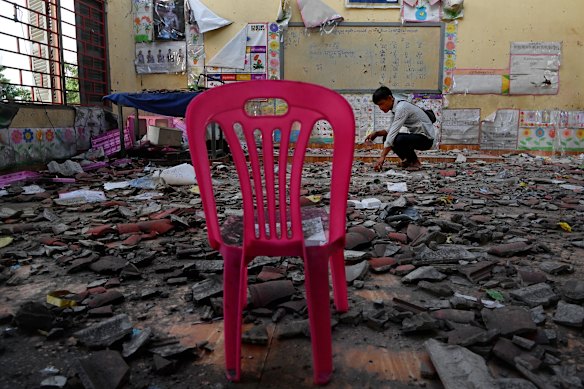
Teacher Srun Ngep inspects the damage in the kindergarten classroom.Credit: Kate Geraghty
“We don’t know what will be the next step,” he says. “We will ask for donations.”
The school and pagoda are a few kilometres from the ancient Ta Moan Thom temple, which proved to be at the centre of the five-day war that ended last week after claiming dozens of lives, including civilians, and displacing hundreds of thousands of Thais and Cambodians.
Both sides claim Ta Moan Thom as sovereign territory, along with several other temples along swaths of ambiguous border between the two countries. Importantly, these temples are on the Dangrek mountain range, the last stronghold of the Khmer Rouge in the 1990s, and vital geography should Thailand and Cambodia ever enter into full-scale war.
It was on to Ta Moan Thom that a group of Cambodian citizens descended in February to sing patriotic songs, infuriating the Thai troops stationed there and politicians in Bangkok. Thai Defence Minister Phumtham Wechayachai, currently the acting prime minister, worried at the time that the stunt could needlessly escalate Cambodian-Thai tensions. It did.
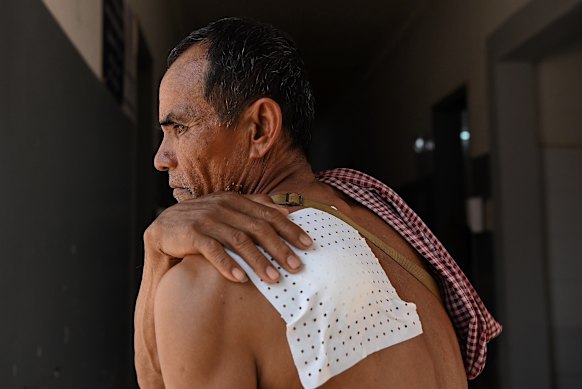
Civilian Khek Vin, 65, was wounded by shrapnel when his house, near Ta Krobei Temple, was hit by artillery.Credit: Kate Geraghty
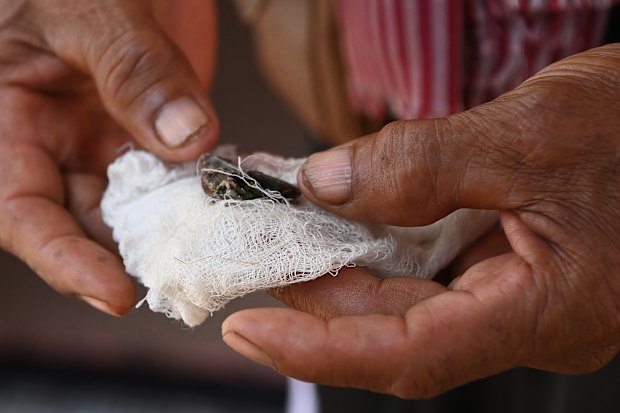
Khek Vin holds a piece of shrapnel removed from his body after his house was hit by artillery.Credit: Kate Geraghty
The most serious precursor to the armed clashes was a May 28 border skirmish at an area known as the Emerald Triangle – the convergence of Thailand, Cambodia and Laos – that left a Cambodian soldier dead.
As in the most recent fighting, both sides accused each other of striking first that time. The rhetoric and war posturing mounted.
Asked why his school was bombed, Lay Phalla suggests “confusion”. He says the initial May 28 incident prompted his staff to dig a rudimentary bomb shelter at the front of the school, made of sandbags and tarpaulin – just in case.
“When they saw the bunker, maybe they thought it was a military base,” he says of the Thai military. “This is just my thinking.”
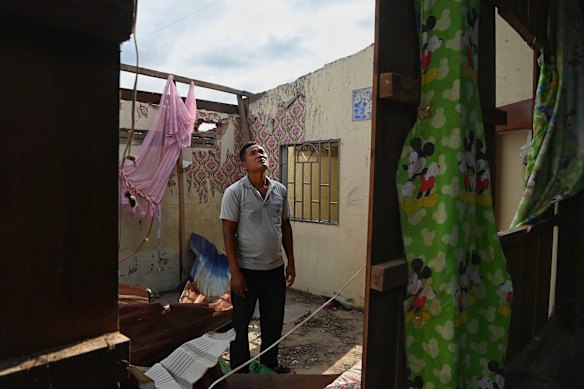
Luon Chanthak inside the ruins of his home, damaged by the explosion of a MK-84 bomb fired by the Thai military. The Cambodian soldier was off duty and at home near Thma Daun village when it exploded.Credit: Kate Geraghty
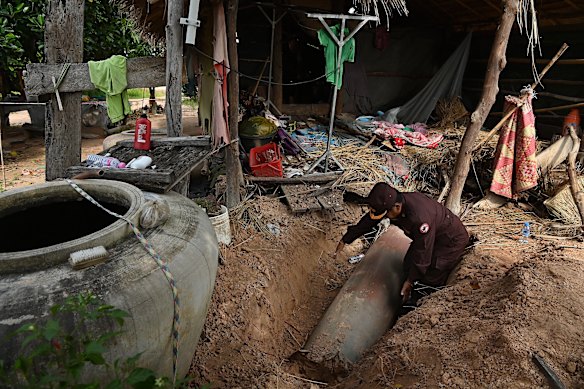
A Cambodian Mine Action Centre officer inspects an unexploded MK-84 bomb fired by the Thai military that remains in the ground at the rear of the home of a farmer near Thma Daun village/\.Credit: Kate Geraghty
Phalla and achars at the pagoda insist there were no soldiers or military installations anywhere near their school and temple when they were bombed, an assertion this masthead could not verify.
The Thai military did not respond to questions, or to photo evidence of civilian-infrastructure bombing.
Breaches defy Trump’s ceasefire
The true death toll from the five-day war remains unclear, though it is believed to be upwards of 40. Thailand appears to have borne the bulk of civilian casualties. In one incident – an alleged Cambodian rocket attack on a petrol station in Si Sa Ket province – eight people, including children, were killed, Thai media has reported.
Elsewhere, Thailand has accused Cambodia of firing heavy artillery towards hospitals and schools, which the government says breaches the Geneva Conventions on war. Towns on both sides of the border emptied when the fighting broke out, as terrified citizens sought shelter with faraway families, or at camps set up for internally displaced people.
The fighting has quietened since a ceasefire came into effect at midnight on July 28. US President Donald Trump, who told Thailand and Cambodia to stop fighting or suffer terrible trade deals, has both claimed and been given the credit for the truce.
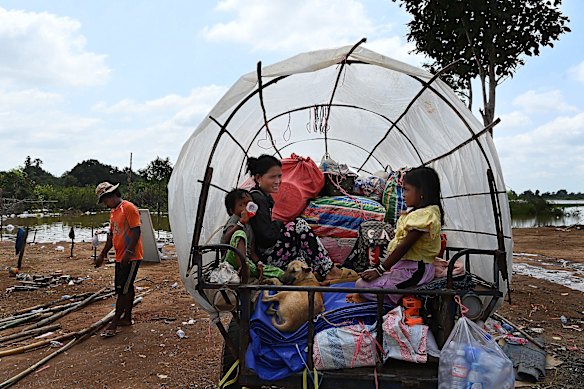
Thoeun Sida (second from right) and her children Lok Vina, 4 (second from left), and Lok Chanthy, 5, (right), in their shelter.Credit: Kate Geraghty
On the day Trump’s administration announced a 19 per cent tariff rate for both countries – well below the 36 per cent he had earlier indicated would come into force – this masthead spotted a giant electronic billboard in the middle of a Siem Reap roundabout labelling Trump the “President of Peace”.
“Support Donald Trump for the Nobel Peace Prize,” it read.
However, both sides have claimed ceasefire breaches since the truce took effect last week. At least 16 Cambodian soldiers were taken prisoner the morning after the truce was signed, and at the time of writing, they were still in Thailand.
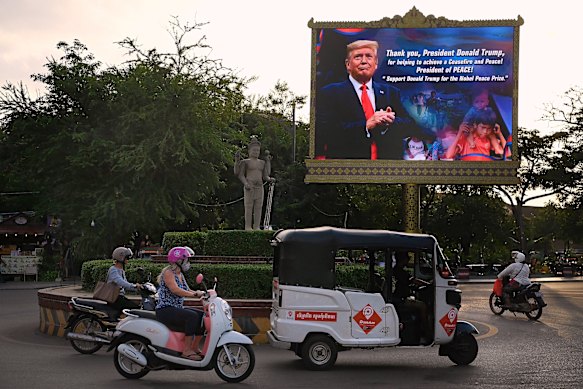
A billboard thanking Donald Trump in Cambodia on Friday.Credit: Kate Geraghty
One is Vy Chhorvon. We visit his parents as they wait for news about their son. They sit at the end of a wooden table, his father scrolling Facebook for news, his mother weeping, surrounded by close to 50 neighbours offering them support.
With no information from their government or Thailand about the fate of their son, the family acts the next day on social media rumours that there will be a handover at a border crossing called Choam, more than two hours’ drive away.
Following the same rumour, we find them again at the crossing. They are still waiting, still unsure if their son is among two soldiers suspected to have been killed. The prisoner handover does not happen.
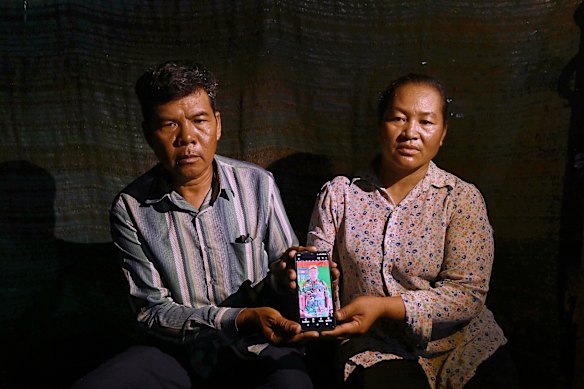
At their home in Sret East village, Vowung Vy (left) and Trip Huon (right), hold a photo of their son, Vy Chhorvon.Credit: Kate Geraghty
While the fighting may have eased in this part of South-East Asia, underlying tensions between Thailand and Cambodia – and the propaganda war on social media – have not. Fake pictures of downed Thai F-16 fighter planes circulated online on the first day of fighting.
And one of the most serious accusations levelled at Thailand is that it dropped deadly, toxic smoke onto Cambodian positions at a temple called Ta Krabei. There is no evidence yet to support this and it is vehemently denied by Thailand. But Mao Sophal, the wife of dead Cambodian soldier Cheuk Chhon, is convinced it was the smoke that killed her husband.
He died on Friday after vomiting blood for days in hospital, she says.
At Chhon’s Buddhist funeral, mourners have cut out a cardboard photo of his face and taped it onto a mannequin dressed in military uniform. Sophal, kneeling near her husband’s yet-to-be cremated body, is so overcome with grief she needs help getting back to her feet.
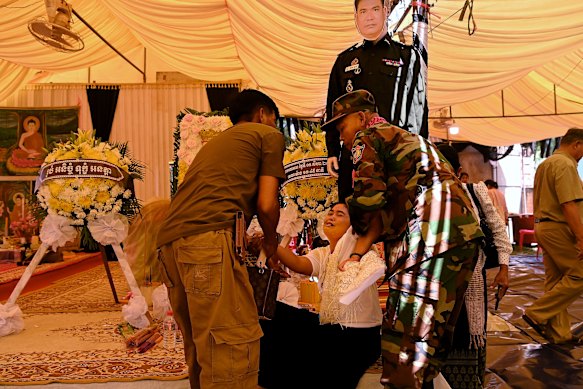
Mao Sophal, the widow of Cambodian soldier Cheuk Chhon, is overcome with grief at his funeral near Siem Reap.Credit: Kate Geraghty
But Chhon’s uncle Pich Sokun explains it was not toxic smoke that killed his nephew. He says the pair were fighting together on Ta Krabei, and Chhon came down from the mountain feeling sick on July 27.
Whatever “red and grey” substance that allegedly made the Cambodian soldiers feel like they were “choking” – forcing them to cover their mouths and noses with bandannas – wafted down from a Thai plane the following day, Sokun says.
A mad dash for safety
Days after the shaky ceasefire, Cambodian refugee camps remain crowded with the families heeding provincial authorities’ advice that it is too soon to go home.
One of the youngest seeking refuge at a sprawling camp near Samraong City is Lin Kakada. She was born on July 24, the day the fighting began. Her mother, Hong Srey Rith, says she felt the labour pains start as her family were packing up their belongings to flee.
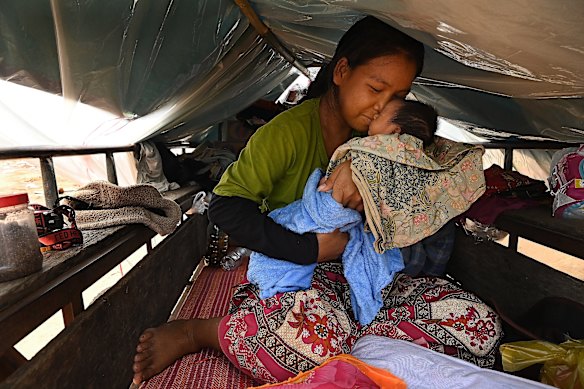
Hong Srey Rith holds her eight-day-old baby, Lin Kakada, in their shelter at the Batthkav primary school. Srey Rith went into labour as she fled her home.Credit: Kate Geraghty
Mother and baby spent one night in hospital but have been at the camp ever since, sitting in a wagon parked by a fetid reservoir, taking their shade from a tarpaulin.
Srey Rith says she needs baby formula to supplement her breastmilk, but it is too expensive.
“It is very difficult,” she says of her living conditions. “It is windy. It is raining. It is hot. I want to go home, but the authorities don’t want that yet. There’s a chance there will be more fighting. I’m afraid, too, that it will continue.”
The camp’s presumed oldest resident shelters about 100 metres away. Ron Touch is 98 years old and mostly blind. Even with the horrors she has survived in her lifetime – the Khmer Rouge, the international wars, the civil wars – this fighting has rattled her. “Yes, I’m scared,” she says.
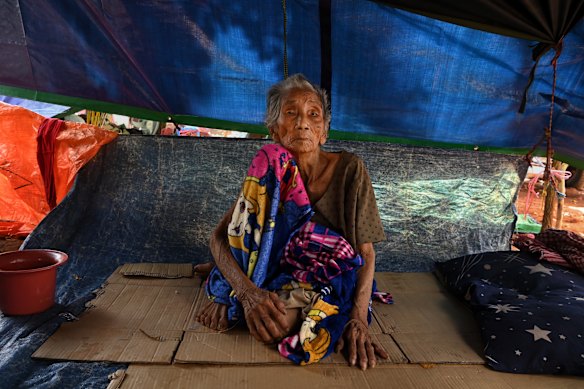
Ron Touch, aged 98, sits in her family’s shelter at the Batthkav primary school.Credit: Kate Geraghty
Loading
Over three days on the frontline, we ask the same question to dozens of Cambodians: do you want the ceasefire to hold, or do you want your soldiers to push on and take strategic territory and temples?
To a man and woman, from farmers to frontline soldiers, without hesitation, Cambodians say they want peace.
Get a note directly from our foreign correspondents on what’s making headlines around the world. Sign up for our weekly What in the World newsletter.




